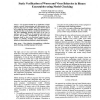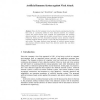92 search results - page 3 / 19 » Detecting Unknown Worms Using Randomness Check |
ITIIS
2010
13 years 3 months ago
2010
There is a well-defined propagation model, named the random constant spread (RCS) model, which explains worms that spread their clones with a random scanning strategy. This model ...
IAW
2003
IEEE
13 years 10 months ago
2003
IEEE
- Use offormal methods in any application scenario requires a precise characterization and representation of the properties that need to be verified The target, which is desired ri...
ICCS
2004
Springer
13 years 10 months ago
2004
Springer
Since the first computer virus has been found, scanning detection has been used as a primarily method in virus detection systems. As computer viruses and worms become more complex ...
ICSE
2008
IEEE-ACM
14 years 5 months ago
2008
IEEE-ACM
Modern worms can spread so quickly that any countermeasure based on human reaction might not be fast enough. Recent research has focused on devising algorithms to automatically pr...
WORM
2003
13 years 6 months ago
2003
This paper presents DOME, a host-based technique for detecting several general classes of malicious code in software executables. DOME uses static analysis to identify the locatio...


